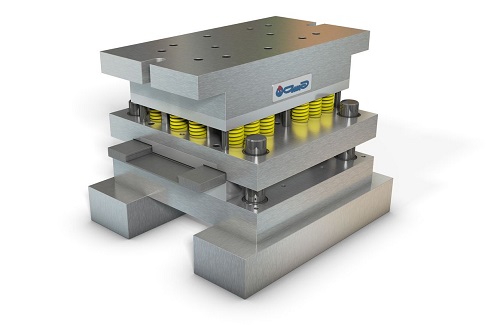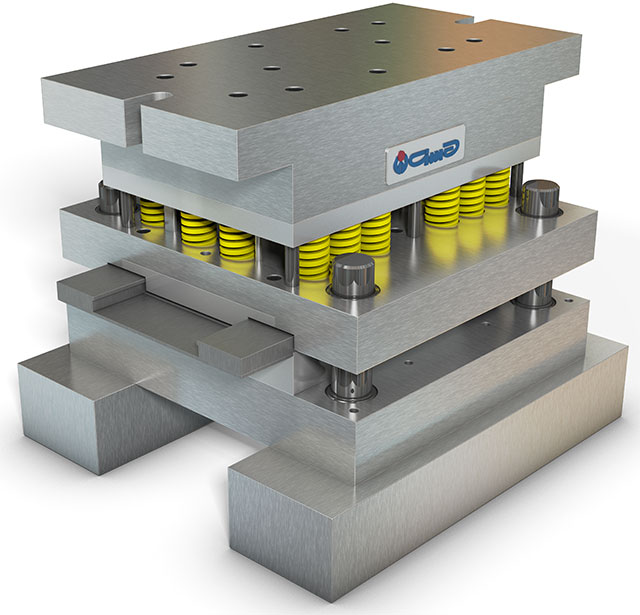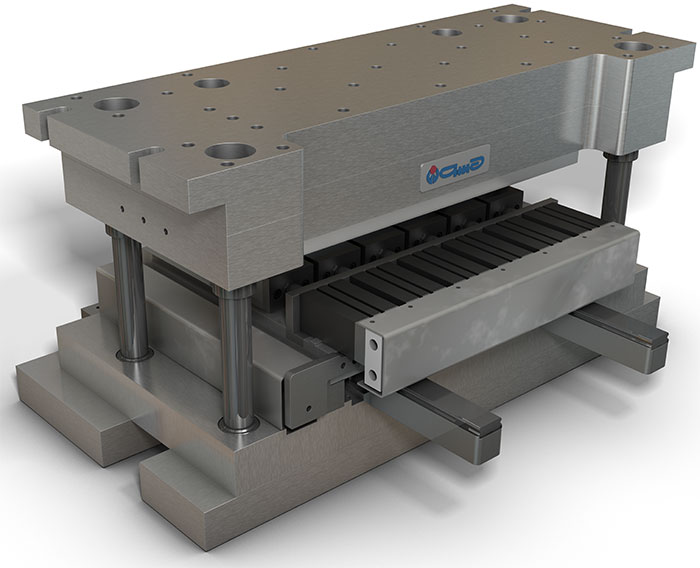Un’officina meccanica altamente specializzata, fornita di centri di lavoro CNC a 4 assi, diverse elettroerosioni a filo e rettifiche parallele permettono a Gima Spa di offrire un servizio di progettazione e costruzione stampi all’avanguardia.
Gima Spa è in grado di progettare, costruire, ingegnerizzare e riparare stampi a passo, stampi transfer, ma anche stampi a blocco, di ripresa, e per ogni esigenza di produzione.
Fra le altre cose, Gima Spa è dotata di un ufficio progettazione che utilizza software CAD/CAM a supporto della creazione di stampi e sistemi di automazione.
Analisi FEM, rendering, implementazione di PLC industriali, Arduino e Raspberry PI per i controlli della produzione, impianti pneumatici ed oleodinamici sono tutte attività che concorrono a fare di Gima Spa un’azienda moderna e innovativa nella realizzazione stampi.

La costruzione stampi

L’intero reparto è nato con la costruzione di stampi per la modellazione a freddo della lamiera. I primi sono stati realizzati per i formifici di tutto il mondo, stampi progressivi a passo per la tranciatura, piegatura e coniatura, che hanno reso la Gima spa leader mondiale nel settore degli accessori per forme di calzature. Nel 1987 vengono acquistati ed in seguito realizzati i primi stampi transfer per le imbutiture; l’intero progetto, dal quadro elettrico alla movimentazione meccanica, viene seguito e modellato completamente all’interno dell’azienda.
I principali stampi realizzati da Gima spa sono quelli a passo e quelli transfer. La differenza fondamentale fra gli stampi a passo e gli stampi transfer è il modo nel quale il pezzo viene portato avanti nei vari passaggi, e cioè fra una lavorazione e un’altra.
Gli stampi progressivi a passo realizzano uno o più particolari ad ogni colpo della pressa. La lunghezza dello stampo è ovviamente determinata dal numero di passi, cioè dalle varie lavorazioni da eseguire e dalla complessità del particolare, che viene fatto avanzare assieme alla lamiera, la quale entra sotto forma di nastro all’interno dello stampo.
Negli stampi transfer invece, il particolare da ottenere viene movimentato appunto da un transfer, che ad ogni colpo della pressa preleva il pezzo da una stazione e lo porta alla successiva. Generalmente sono utilizzati per le lavorazioni di imbutitura, dove non sempre il pezzo può essere lasciato attaccato al nastro.
Altri tipi di stampi realizzabili e riparabili da Gima spa nelle proprie officine sono quelli a blocco e quelli “di ripresa”.
Sistemi di automazione

L’automazione sta assumendo un ruolo sempre più importante nel moderno mercato, dove l’abbattimento dei costi e il miglioramento delle condizioni di sicurezza dei lavoratori divengono sempre di più elementi al centro del processo lavorativo.
Anche all’interno di Gima Spa si sta operando in questo senso: nel corso del 2014, per esempio, sono stati progettati sistemi di automazione oleodinamica implementati all’interno degli stessi stampi, così come era già stato fatto negli anni precedenti con automazioni pneumatiche.
PLC vengono installati periodicamente, e in alcuni casi, sono stati adottati microcontrollori open source direttamente fissati sulle piastre dello stampo, così da evitare complicati e delicati cablaggi elettrici.
Software e Tecnologie
 L’ufficio progettazione di Gima Spa è fornito dei migliori software a supporto della progettazione, creazione e automazione degli stampi.
L’ufficio progettazione di Gima Spa è fornito dei migliori software a supporto della progettazione, creazione e automazione degli stampi.
Gima Spa investe continuamente sull’innovazione software e sulla formazione del personale, in modo da offrire al cliente servizi di maggior qualità a tempi e costi ridotti.
CAD è l’acronimo di Computer Aided Design cioè “Progettazione Assistita da Calcolatore”, e indica i software per la progettazione intesa in tutte le sue fasi.
I primi programmi di disegno tecnico in 2D permettevano di realizzare in maniera veloce e formale quello che un tempo veniva realizzato sopra un tecnigrafo, utilizzando squadre e matita. Con l’evoluzione dei computer e la massiccia informatizzazione, i software CAD si sono via via sempre più evoluti e sono stati introdotti i primi modellatori 3D parametrici.
Una volta che il particolare viene disegnato e modellato all’interno di software CAD, questo dovrà essere realizzato in officina. A supporto della produzione vengono utilizzati programmi CAM, acronimo di Computer Aided Manufacturing e cioè “Produzione Assistita da Calcolatore”.
Tali software permettono, partendo da una geometria 2D o 3D, di realizzare e calcolare i vari percorsi utensili e quindi i programmi da dare in “pasto” alle varie macchine a controllo numerico computerizzato (CNC).
Ogni tipologia di lavorazione generalmente è assistita da uno specifico software CAM, centri di lavoro, elettroerosioni, torni, ecc. Oggi, la programmazione dei CNC può essere quindi eseguita interamente all’interno di un ufficio con l’ausilio di un computer.
I software utilizzati
A oggi Gima Spa utilizza Autodesk Product Design Suite Ultimate, un pacchetto che comprende:
- Inventor Professional come principale software di modellazione solida 3D e analisi FEM
- AutoCad Mechanical per il disegno 2D
- AutoCad Electrical per la progettazione degli impianti elettrici e dei circuiti
- 3ds Max per il rendering foto realistico
- Recap per le scansioni 3D.
Alla suite Autodesk viene affiancato Dassault Systemes CATIA per la modellazione di superfici e per il CAM delle macchine utensili.
L’intero sviluppo tecnologico sopra descritto non avrebbe avuto applicazione se l’azienda non avesse investito, e continuasse tuttora ad investire, in un parco macchine sempre all’avanguardia e nella formazione costante dei lavoratori, coadiuvati da postazioni CAD/CAM con calcolatori sempre più potenti e software aggiornati.
